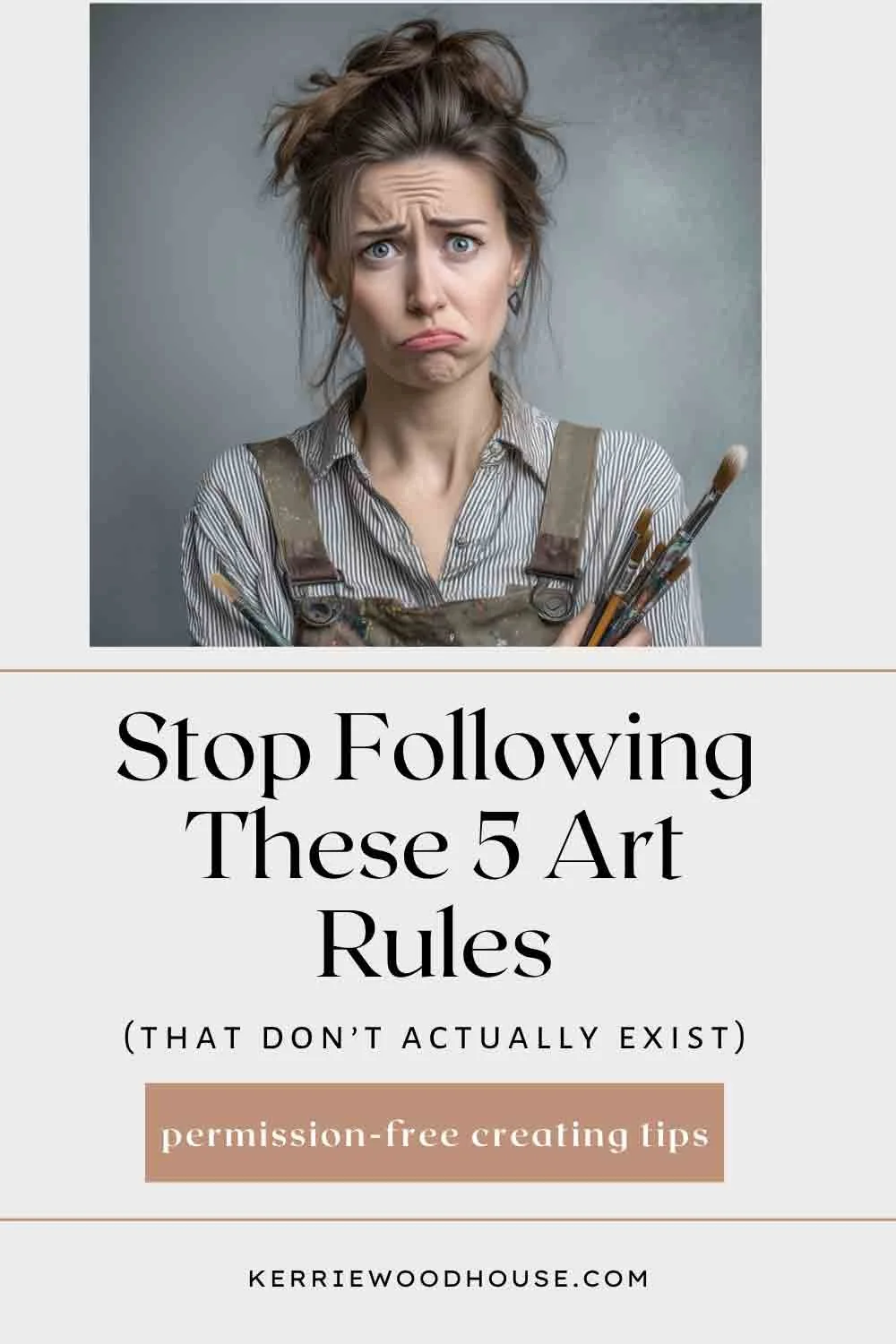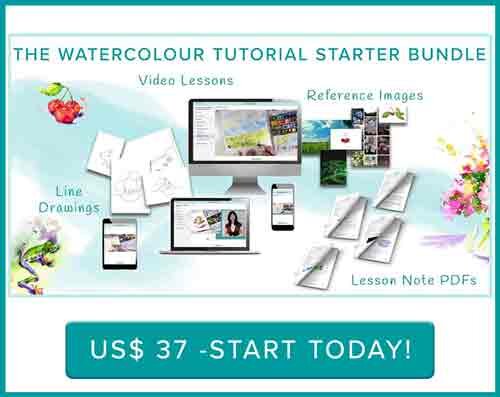Permission-Free Art: How to Start Creating Without Following Made-Up Rules
There are no art police.
Let me say that again: there are no art police. Yet somehow, it feels like they're watching, doesn't it? Those nagging voices in our heads, the guilt, the endless "shoulds" that sneak in and steal the joy from creating.
If you've ever found yourself thinking thoughts like these, you're not alone:
"I should really be doing something more useful than painting"
"I wish I had started when I was younger"
"I need to learn to draw first before I can paint"
"Real artists know colour theory inside and out"
Sound familiar? These are the unwritten rules we've somehow adopted about art and creativity. But here's the truth: all of those rules are completely made up.
Where Do These "Rules" Come From?
These creative limitations don't appear out of nowhere. They're often inherited from:
Traditional art education systems that emphasize technical skill over creative expression
Social media perfectionism where we only see polished final results, never the messy learning process
Well-meaning advice from other artists who learned in a particular way and assume it's the "right" way
Childhood experiences where our creative attempts were criticized or corrected
Productivity culture that makes us feel guilty for doing anything that isn't obviously "useful"
Understanding where these mental barriers come from is the first step in dismantling them. Remember: just because someone taught you there was a "right way" doesn't mean they were actually right.
The Tyranny of "Should"
I'm always wary when I hear the word "should" creep into conversations about art. Sometimes we say "I should learn colour theory" because we genuinely want to—and that's wonderful! But more often, we're saying it because we feel we ought to, as if there's some predetermined curriculum we must follow to earn our artistic credentials.
This is supposed to be fun, remember?
After years of adulting, of doing the right thing in the proper order, maybe it's time to set all that aside and just have a little fun with our creativity.
The Psychology of Creative Permission
There's something profound that happens when we give ourselves permission to create without rules. Research shows that when we approach creative activities with a playful mindset rather than a performance mindset, we actually:
Reduce cortisol levels (the stress hormone that blocks creative thinking)
Increase dopamine production (which enhances learning and memory)
Access flow states more easily (where our best creative work happens)
Build resilience through low-stakes experimentation
When we're constantly worried about doing things "right," we're operating from our anxious, analytical brain. But creativity flows from a more relaxed, exploratory state of mind. This is why children are naturally so creative - they haven't yet learned to judge their attempts before they've even begun.
Think of Art as a Buffet
I like to think of our art adventures as a buffet. You can walk up to the table, browse, and pick whatever appeals to you in whatever order you like. Want dessert before your main course? Go right ahead! Don't worry about how many vegetables you've had, and if you want second helpings of something, help yourself.
The same goes for learning art skills. There's no rule that says you must master drawing before you can enjoy painting, or that you need to understand colour theory before you can splash some happy colours on paper.
Common Art "Rules" That Are Actually Myths
Let's tackle some of the most persistent creative myths head-on:
Myth 1: "You should learn to draw before you can paint" Reality: Many successful painters started with colour and composition, developing drawing skills alongside or even after their painting journey. Van Gogh was largely self-taught, and Grandma Moses didn't start painting until she was 78!
Myth 2: "Real artists should be able to mix any colour from just three primaries" Reality: Professional artists use whatever tools make their work easier and more enjoyable. Most have dozens of tubes of paint because sometimes you want convenience, and sometimes certain pigments create effects you can't easily mix.
Myth 3: "You should never trace or use references" Reality: Almost every professional artist uses references. Even Leonardo da Vinci used camera obscura (an early projector) for his paintings. The goal is to create something meaningful, not to prove you can work without tools.
Myth 4: "Art should be realistic to be good" Reality: Some of the most celebrated artists in history were abstract expressionists, impressionists, or worked in stylized ways. Picasso could paint realistically - he chose not to because it wasn't what excited him.
Myth 5: "You should start when you are young" Reality: Laura Ingalls Wilder didn't publish her first Little House book until she was 65. Colonel Sanders was 62 when he franchised KFC. Your creative journey can begin at any age.
The Magic Question
Whenever I catch myself falling into the "should" trap, I ask myself one simple question: "Would it be fun to do that thing?"
Let's apply this to those common creative roadblocks:
"I should learn to draw first" → Would it be fun to learn to draw right now? If yes, great! If no, don't worry about it. Trace, jump into painting, do something else. Maybe you'll come back to drawing later, maybe you won't—but there's no point denying yourself the joy of painting just because you think there's a predetermined order.
"I should have started younger" → Would it be fun to start now? If yes, then jump in and be a beginner! If you think you should have started younger, you'd better start today because tomorrow you're going to be a day older.
"I should be doing something more useful" → Would it be fun to paint right now? If that little voice in your head is saying a doodle or some splash of color would make you feel happier, give yourself permission. Ten minutes, an hour - whatever it takes. You might find that creative moment gives you the energy to tackle those "more important" tasks.
What Moves Us, Moves Us
Here's something I've discovered: when we're feeling down or lacking energy, but some part of our brain is craving creative expression, that's not frivolous. It's our inner wisdom speaking. Following that creative impulse often gives us the motivation and energy we need for everything else.
Instead of forcing yourself through the chore to earn painting as a reward, try doing the creative work first. See if it transforms the chore into something that feels less burdensome.
Building Your Permission-Based Art Practice
So how do you actually implement this rule-free approach? Here are some practical strategies:
Start a "10-Minute Rule": Commit to just 10 minutes of creative play when the urge strikes. No setup required, no finished product expected. Just pure experimentation.
Create a "Permission List": Write down all the things you've been telling yourself you "can't" do until you learn X or master Y. Then give yourself explicit permission to try them anyway.
Embrace the Beginner's Mind: Instead of trying to create something good, try to create something interesting to you. Ask "What would happen if...?" instead of "How do I make this right?"
Keep an "Art Snack" Kit: Have basic supplies easily accessible so you can act on creative impulses without the barrier of setup time. Colored pencils, watercolor pencils, or even crayons work perfectly.
Document Your Joy, Not Just Your Progress: Instead of only keeping finished pieces, take photos of moments when you felt excited about creating. These remind you why you started.
When the Troll Thoughts Strike Back
Even with the best intentions, those limiting thoughts will creep back in. Here's how to handle them:
"This isn't good enough": Ask instead, "Am I enjoying this process?"
"I'm wasting time": Remember that play is how we learn and recharge. It's not wasted time—it's essential time.
"Other people are so much better": Their skill level has nothing to do with your right to create and enjoy the process.
"I should be more disciplined about practicing": Replace "should" with "could." You could practice more, or you could paint exactly as much as brings you joy right now.
"I don't have enough talent": Talent is largely developed through enjoyment and practice. If you're having fun, you're developing.
The Bottom Line
If there's one thing I want you to take away from this, it's this: there really are no rules. You don't need permission from anybody, and you can approach your art in any way you see fit. The whole point is to have fun.
And here's the beautiful secret: when you're having fun, that's when you make your best work.
So the next time those troll thoughts pop up—those voices telling you what you should or shouldn't do—remember the buffet. Remember that creativity is meant to be joyful. Ask yourself what would be fun, and then give yourself permission to do exactly that.
Your art practice is yours to shape. Make it something that brings you joy, not guilt. The world needs your unique creative voice, not your perfect adherence to imaginary rules.
Remember: there are no art police. There's no creative committee judging whether you've earned the right to enjoy making art. The only permission you need is the permission you give yourself.
So grab those paints, pick up that pencil, or open that sketchbook app. Start exactly where you are, with exactly what you have, doing exactly what sounds fun. Your creative journey is waiting for you to begin - not when you're "ready," but right now.
Are you on your own painting journey?
One of these might be useful…









